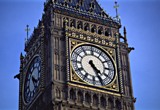|

Fusion of legislative and executive power, the second majoritarian feature
In a majoritarian system, there is a fusion of power between the legislature and the executive. This fusion of power is commonly known as a parliamentary system. In such a parliamentary system, the chief executive--the British Prime Minister (PM), the Prime Minister of Israel, the Bundeskanzler (Federal Chancellor) of Germany--comes to power based on the support of one or more political parties in the legislature which provide an absolute majority of votes to support and maintain that chief executive in power. If one party has an absolute majority of seats in the legislature, its party leader becomes prime minister and, with the heads of the departments (ministers) that he appoints from his party, a cabinet is formed. The cabinet--Prime Minister and other ministers--make up the Government of the Day.
In the 2005 elections, the Labour Party in Great Britain won an absolute majority of seats in the House of Commons (356 out of 646), and so Labour's party leader, Tony Blair, became Prime Minister; Blair appointed various other Labour members of the House of Commons to ministerial positions, together making up the Government of the Day. (Subsequent to this election, Blair resigned as prime minister but, because his party maintained an absolute majority of seats the Commons, he was succeeded as prime minister by the deputy party leader, Gordon Brown who continued to serve as PM until the general election in the summer of 2010 when things got really interesting.)
A fundamental principle of parliamentary government is that the Government of the Day must have the confidence of parliament. In other words it must at all times be able to claim the support of an absolute majority of members of the parliament. The Government of the Day will have the confidence of parliament so long as one party has an absolute majority of seats (which will occur so long as there are only two parties in parliament, something that should result if SMDP, the majoritarian electoral law, is used) and members of parliament vote along party lines, exhibiting what is called party discipline. (In parliamentary systems, party leaders typically have a lot of influence over who gets to run as the party's nominee in legislative elections, tying legislators to their party leaders.) In the British case, on all matters when leaders "crack the whip," which is most of time time, Labour Party members of Parliament (MPs) vote in favor of bills put forward by its party leaders (Gordon Brown and others) who make up the Government of the Day. (MCs from other parties, the Opposition, will oppose these motions but without effect; because the Government's party has an absolute majority of seats, it wins every vote.) If, on the other hand, enough MCs from the Government's party defect and vote against their party leader, Government bills will go down to defeat, and the Government will have lost the confidence of parliament, and so will resign, in which case it is said the Government has fallen. When the Government falls, there may be a dissolution of parliament, in which case all MPs will lose their positions, and will have to run to regain their seats in new elections. (Wikipedia has a helpful discussion of the motion of confidence.)
In the event a parliamentary system uses a nonmajoritarian electoral law--which would render the system as a whole not majoritarian--it may well be that no one party has an absolute majority of seats in parliament, with the result that a coalition government will be formed based on a temporary agreement of two or more parties to cooperate to form a Government of the Day. There will still be a fusion of legislative and executive power so long as the MPs from the parties in the coalition maintain party discipline and support the government. (After February 2009 elections in which 12 parties won legislative seats, but the largest party won ony 23% of the seats, far from an absolute majority, Israel faced a problem of forming a majority coalition.)
Because the Government of the Day is based on control of an absolute majority of seats in parliament and because MCs from the government party vote in every instance to support the Government, legislative and executive power are linked, are fused, moving together in an interlocking fashion.
Recall that this fusion of legislative and executive power is a majoritarian feature; if there is a majoritarian form of government, there will be a fusion of legislative and executive power and unicameralism.
A nonmajoritarian alternative to a fusion of legislative and executive power is separation of powers where the legislative and executive branches operate with a greater degree of independence from each other. An obvious example of separation of powers is the United States where the president is elected separately from members of Congress; occupies the office for a four year term whether or not members of Congress support his policies; and may be faced with one or both houses of Congress under the majority control of the opposition party. From the congressional perspective, in this separation of powers, the two chambers may pass bills opposed by the president, but he may choose to block them by exercising his veto (which may be overridden only by two-thirds majorities in both the House and the Senate). Essentially, the Congress does its thing, the president does his thing, and only if those things happen to be the same will anything get done. Because members of Congress are not obliged to vote along party lines--and, indeed, national party leaders have little to no control over who gets the party's nomination for legislative seats--and because the president stays in office whether or not he can secure congressional support for his program, policymaking in the US system is a constant process of forming coalitions of House members and then Senate members in favor of legislation that may then be signed into law by the president. The 2003 prescription drug struggle is a messy case in point.
Here is a good time to make another point. While a majoritarian system will have all of the majoritarian features exactly as they have been set out, there is not one specific set of nonmajoritarian alternatives. (This is why in the previous paragraph I wrote "A nonmajoritarian alternative...." There may be several nonmajoritarian alternatives to a particular majoritarian feature.) The French case shows this. France also has a parliamentary system in which the premier, equivalent to a prime minister, and her cabinet can stay in power only so long as it has a parliamentary majority (that is, is backed by an absolute majority of the members of the National Assembly, the dominant house of the French bicameral legislature). On the other hand, there is also a president of France who is elected independently of members of the National Assembly and who has some specific powers, especially in foreign affairs. This is clearly nonmajoritarian but it also differs from the US separation of powers. This aspect of French nonmajoritarianism is sometimes referred to as a hybrid model, but that suggests it is somewhere between the British and US cases which I don't think is a very good way to look at things. It's French. Another term used for the French and similar cases is semipresidentialism.
And, now, on to the third majoritarian feature, parliamentary sovereignty...
|


